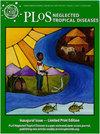肯尼亚上东部伊西奥洛县人、牲畜和特定野生动物与克里米亚刚果出血热病毒的接触模式和风险因素
IF 3.4
2区 医学
Q1 Medicine
引用次数: 0
摘要
克里米亚刚果出血热(CCHF)是一种由克里米亚刚果出血热病毒(CCHFV)引起的蜱媒人畜共患病。这种疾病的传播周期复杂,涉及多种宿主,包括哺乳动物和某些种类的鸟类。我们在肯尼亚伊西奥洛县开展了一项血清流行病学研究,以确定 CCHFV 在人类、牲畜和野生动物中的相对血清流行率。血清阳性畜群的定义是至少有一只动物血清阳性。此外,我们还确定了可能导致接触 CCHFV 的主体和环境因素。本研究通过多阶段随机抽样技术招募了人类(n = 580)和家畜(n = 2,137),此外还方便地抽取了各种野生动物(n = 87)。收集所有被招募的人类和动物的血清样本,并使用 ID Screen 多物种、双抗原 IgG 酶联免疫吸附试验(ELISA)筛查 CCHFV 抗体。人、牛、山羊、绵羊和骆驼的抗 CCHFV IgG 血清总流行率分别为 7.2% [95% CI:3.1-15.8%]、53.9% [95% CI:30.7-50.9%]、11.6% [95% CI:7.2-22.5%]、8.6% [95% CI:3-14%] 和 89.7% [95% CI:78-94%]。平均而言,采样野生动物的 CCHFV 血清流行率为 41.0% [95% CI:29.1-49.4%];长颈鹿的平均 CCHF 血清流行率最高,其次是水牛,而黑斑羚的接触水平很低。使用混合效应逻辑回归模型进行的统计分析显示,人类接触 CCHFV 与男性、30 岁以上和属于血清阳性畜群的家庭密切相关。在牲畜中,动物和环境层面的综合因素(包括年长动物、归一化差异植被指数(NDVI)高和高蒸汽压赤字)与CCHFV感染密切相关。在分析中,野生动物的年龄、性别和种类被认为是关键的风险因素,但这些变量均不显著(P 值分别为 0.891、0.401 和 0.664)。此外,RT-qPCR 分析显示,骆驼(30%)、牛(14.3%)和山羊(3.8%)体内存在 CCHFV RNA,而人、绵羊和野生动物体内则没有。这项研究表明,NDVI 和水汽压差等环境因素会影响牲畜的 CCHFV 暴露,而受感染牲畜的存在则是决定家庭层面人类暴露的关键因素。这些发现强调了采用 "一体健康 "方法在人类-牲畜-野生动物交界处控制该疾病的重要性。例如,现有的慢性阻塞性肺病监测措施可以通过纳入算法来加强,这些算法可以根据研究中确定的环境因素来模拟疾病风险。此外,对牲畜进行蜱虫控制,如使用杀螨剂,可以减少牲畜的 CCHFV 暴露,从而减少人类的 CCHFV 暴露。本文章由计算机程序翻译,如有差异,请以英文原文为准。
Exposure patterns and the risk factors of Crimean Congo hemorrhagic fever virus amongst humans, livestock and selected wild animals at the human/livestock/wildlife interface in Isiolo County, upper eastern Kenya
Crimean Congo hemorrhagic fever (CCHF) is a tick-borne zoonotic disease caused by CCHF virus (CCHFV). The disease has a complex transmission cycle that involves a wide range of hosts including mammalian and some species of birds. We implemented a sero-epidemiological study in Isiolo County, Kenya, to determine relative seroprevalences of CCHFV in humans, livestock and in wild animals. A seropositive herd was defined as having at least one seropositive animal. In addition, we identified subject and environment level factors that could promote exposure to CCHFV. Humans (n = 580) and livestock species (n = 2,137) were recruited into the study through a multistage random sampling technique, and in addition, various species of wild animals (n = 87) were also sampled conveniently. Serum samples from all recruited humans and animals were collected and screened for CCHFV antibodies using ID Screen multispecies, double-antigen IgG enzyme-linked immunosorbent assay (ELISA). The overall anti-CCHFV IgG seroprevalences in humans, cattle, goats, sheep and camels were 7.2% [95% CI: 3.1–15.8%], 53.9% [95% CI: 30.7–50.9%], 11.6% [95% CI: 7.2–22.5%], 8.6% [95% CI: 3–14%] and 89.7% [95% CI: 78–94%], respectively. On average, the sampled wild animals had CCHFV seroprevalence of 41.0% [95% CI: 29.1–49.4%]; giraffes had the highest mean CCHF seroprevalence followed by buffaloes, while impala had very low exposure levels. Statistical analyses using mixed effects logistic regression models showed that CCHFV exposure in humans was significantly associated with male gender, being over 30 years of age and belonging to a household with a seropositive herd. In livestock, a combination of animal- and environment level factors including older animals, high normalized difference vegetation indices (NDVI) and high vapour pressure deficit were significantly associated with CCHFV infection. Age, sex and species of wild animals were considered the key risk factors in the analysis, but none of these variables was significant (P-value = 0.891, 0.401 and 0.664, respectively). Additionally, RT-qPCR analysis revealed the presence of CCHFV RNA in camels (30%), cattle (14.3%), and goats (3.8%), but not in humans, sheep, or wild animals. This study demonstrates that environmental factors, such as NDVI and vapor pressure deficit, affect CCHFV exposure in livestock, while the presence of infected livestock is the key determinant of human exposure at the household level. These findings underscore the importance of using One Health approaches to control the disease in human-livestock-wildlife interfaces. For instance, the existing CCHF surveillance measures could be enhanced by incorporating algorithms that simulate disease risk based on the environmental factors identified in the study. Additionally, tick control in livestock, such as the use of acaricides, could reduce CCHFV exposure in livestock and, consequently, in humans.
求助全文
通过发布文献求助,成功后即可免费获取论文全文。
去求助
来源期刊

PLoS Neglected Tropical Diseases
Medicine-Infectious Diseases
CiteScore
7.40
自引率
10.50%
发文量
723
审稿时长
2-3 weeks
期刊介绍:
PLOS Neglected Tropical Diseases publishes research devoted to the pathology, epidemiology, prevention, treatment and control of the neglected tropical diseases (NTDs), as well as relevant public policy.
The NTDs are defined as a group of poverty-promoting chronic infectious diseases, which primarily occur in rural areas and poor urban areas of low-income and middle-income countries. Their impact on child health and development, pregnancy, and worker productivity, as well as their stigmatizing features limit economic stability.
All aspects of these diseases are considered, including:
Pathogenesis
Clinical features
Pharmacology and treatment
Diagnosis
Epidemiology
Vector biology
Vaccinology and prevention
Demographic, ecological and social determinants
Public health and policy aspects (including cost-effectiveness analyses).
 求助内容:
求助内容: 应助结果提醒方式:
应助结果提醒方式:


